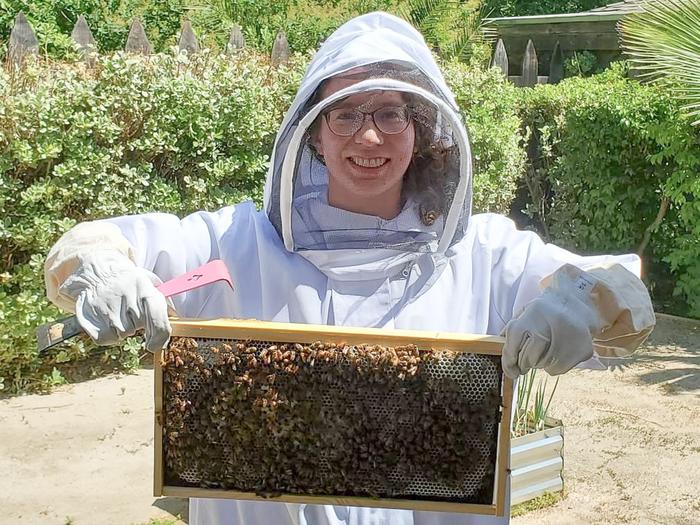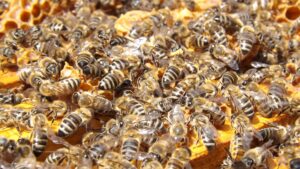As native bee populations decline, crop production that requires pollinators is becoming increasingly reliant on commercial pollination services.
In the U.S., the beekeeping industry is in high demand, with truckloads of bee colonies traveling across the country to meet the needs of crop growers. A new study from the University of Illinois Urbana-Champaign (UIC) explores pollination contracts between beekeepers and California almond growers, examining clauses that could make agreements more attractive to both parties.
“There’s about 1.3 million acres of almond trees in California, and each acre requires two honeybee hives for pollination, so that’s about 2.6 million honeybee hives every year. They are coming from all over the U.S., making the trek to get there by February 15 when the almonds usually start blooming, and they stay for about a month,” Brittney Goodrich, assistant professor in the Department of Agricultural and Consumer Economics at UIC, said in a news release about the study.
Around 90% of the country’s commercial bee colonies gather in California for almond bloom. For the rest of the year, many bees reside in North Dakota or South Dakota for honey production during the summer and in Texas or Florida during the winter.
“You can think of commercial beekeepers as livestock producers who engage in rotational grazing, moving colonies to where flowers are blooming so the bees can find food. I’m interested in how beekeepers deal with risk in their operations and how that affects pollination contracts,” Goodrich said.
Native bee populations face threats from pesticide use, diseases, pests, and decreased native forage land. This has increased the reliance on managed insect pollination for crops.
“We wanted to explore if contracts could include elements that make them more appealing to beekeepers, and whether they would be willing to accept a price discount in exchange for these features. We specifically looked at protection against pesticide exposure, bee-friendly cover crops, and prepayments,” Goodrich explained.
The researchers conducted an online survey of commercial beekeepers who had participated in almond pollination. Participants were asked to consider a standard contract with a typical pollination fee of $200 per hive and two alternative contract options with different clauses and prices, choosing which they preferred. Based on the responses, the researchers estimated the value of each contract clause.
They found that the pesticide protection clause was the most valued, followed by two of the cover crop options. The results were most significant for beekeepers who were more risk-averse and those with previous experience with pesticide exposure.
“Usually, fungicides aren’t harmful to honey bees, but they can become synergistically toxic if they are mixed together. We included a contract clause specifying that growers would not tank mix fungicides and would only apply them at night, when honey bees aren’t foraging, so the risk of exposure is low,” Goodrich said.
Beekeepers were willing to accept an $8 discount per colony for pesticide protection, about 4% of the total pollination fee under the standard contract.
“That may not sound like much, but when the average size of the beekeeping operations we surveyed was 5,700 colonies, it adds up quickly,” Goodrich noted.
The presence of flowering cover crops was also valued, providing nutrition that helps bees better handle pesticide exposure. The survey presented three cover crop options: clovers, a brassica mix, and a soil builder mix with legumes, brassicas, and grasses.
The brassica mix was valued at about $6 per colony, while the soil builder mix was slightly lower. Clovers, though beneficial for bees, bloom later in the season when many bees have already left the almond orchards, making this option less valuable to beekeepers.
“These results are encouraging because cover crops can also provide soil health benefits for almond growers. However, there are often water shortages in California, and growers typically use micro sprinkling systems that only reach the almond trees. There’s a risk of planting cover crops that may not get enough rain to germinate,” Goodrich said.
Discounts in pollination fees could help alleviate costs for growers who plant cover crops or modify pesticide schedules.
The survey also showed that beekeepers value a 40% prepayment before they arrive in California, ensuring income and working capital for transporting colonies and preparing them for pollination. Goodrich suggested this option could work well for growers who can afford an upfront payment.
“Our findings show that farmers of pollinated crops can include features in contracts to make them more attractive to beekeepers. Maybe it won’t necessarily lead to a discount, but it could help attract a beekeeper to your farm that you otherwise wouldn’t have,” Goodrich stated. “For beekeepers, this information provides suggestions for contract negotiations, such as accepting discounts for pesticide protection, cover crops, or prepayment. It highlights ways to create mutually beneficial arrangements.”
The paper, Measuring Beekeepers’ Economic Value of Contract Enhancements in Almond Pollination Agreements, is published in Ecological Economics. Authors include Marieke Fenton, Brittney Goodrich, and Jerrod Penn. The research was supported by Project Apis m., the National Honey Board, and the University of California Giannini Foundation of Agricultural Economics.










